The Priority of Effective Communication: An Analysis for ABC Company
VerifiedAdded on 2023/06/11
|8
|2038
|205
Report
AI Summary
This report investigates the importance of effective communication in the workplace, particularly from a manager's perspective. It examines organizational communication, formal and informal communication channels, and strategies for downward, upward, and horizontal communication. The report highlights the benefits of formal communication, such as enhancing company image and empowering employees, while also addressing the challenges of informal communication, like the spread of rumors and potential impacts on discipline. It concludes that managers should prioritize effective communication by implementing strategies to facilitate the flow of information and achieve organizational goals. Desklib provides access to this document and other valuable study resources.
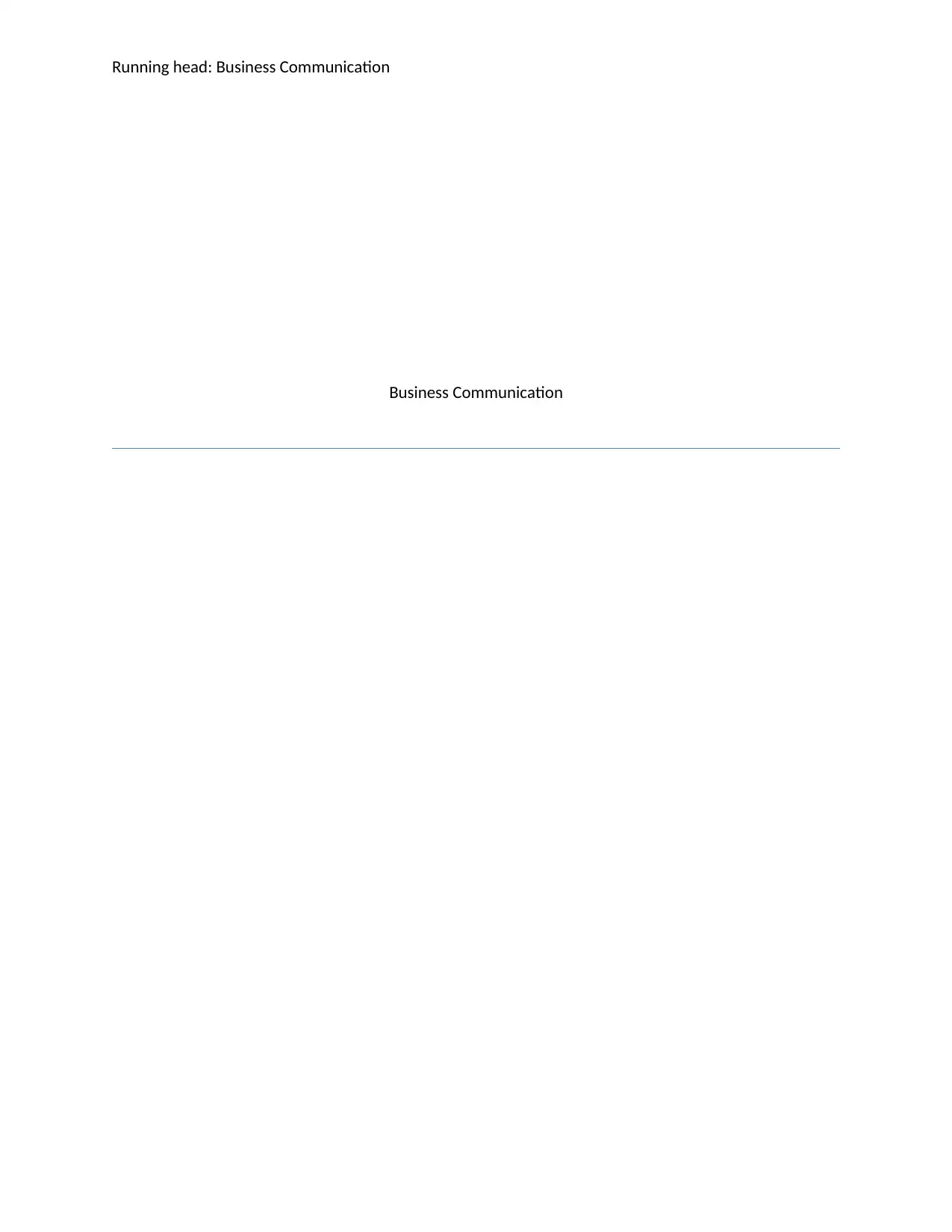
Running head: Business Communication
Business Communication
Business Communication
Paraphrase This Document
Need a fresh take? Get an instant paraphrase of this document with our AI Paraphraser
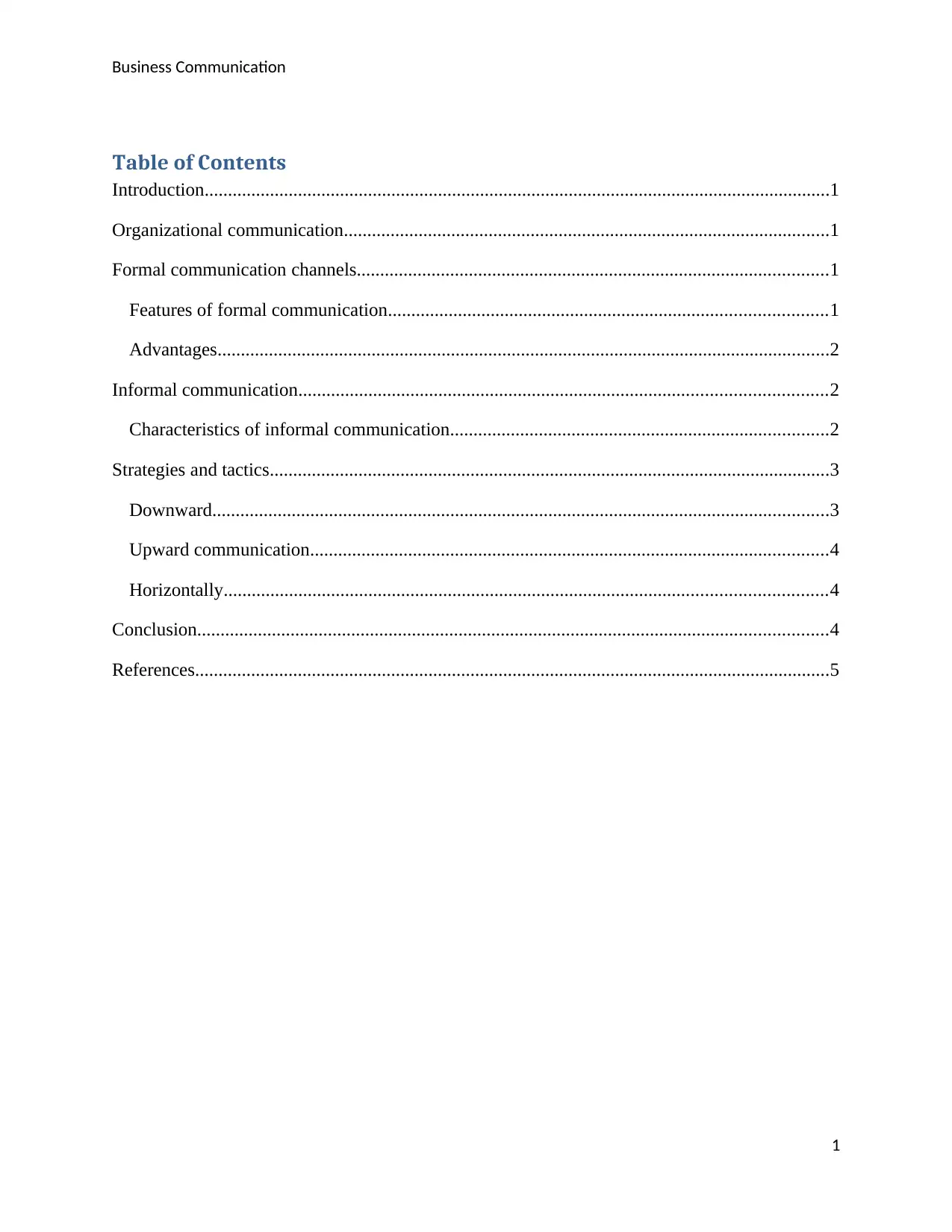
Business Communication
Table of Contents
Introduction......................................................................................................................................1
Organizational communication........................................................................................................1
Formal communication channels.....................................................................................................1
Features of formal communication..............................................................................................1
Advantages...................................................................................................................................2
Informal communication.................................................................................................................2
Characteristics of informal communication.................................................................................2
Strategies and tactics........................................................................................................................3
Downward....................................................................................................................................3
Upward communication...............................................................................................................4
Horizontally.................................................................................................................................4
Conclusion.......................................................................................................................................4
References........................................................................................................................................5
1
Table of Contents
Introduction......................................................................................................................................1
Organizational communication........................................................................................................1
Formal communication channels.....................................................................................................1
Features of formal communication..............................................................................................1
Advantages...................................................................................................................................2
Informal communication.................................................................................................................2
Characteristics of informal communication.................................................................................2
Strategies and tactics........................................................................................................................3
Downward....................................................................................................................................3
Upward communication...............................................................................................................4
Horizontally.................................................................................................................................4
Conclusion.......................................................................................................................................4
References........................................................................................................................................5
1
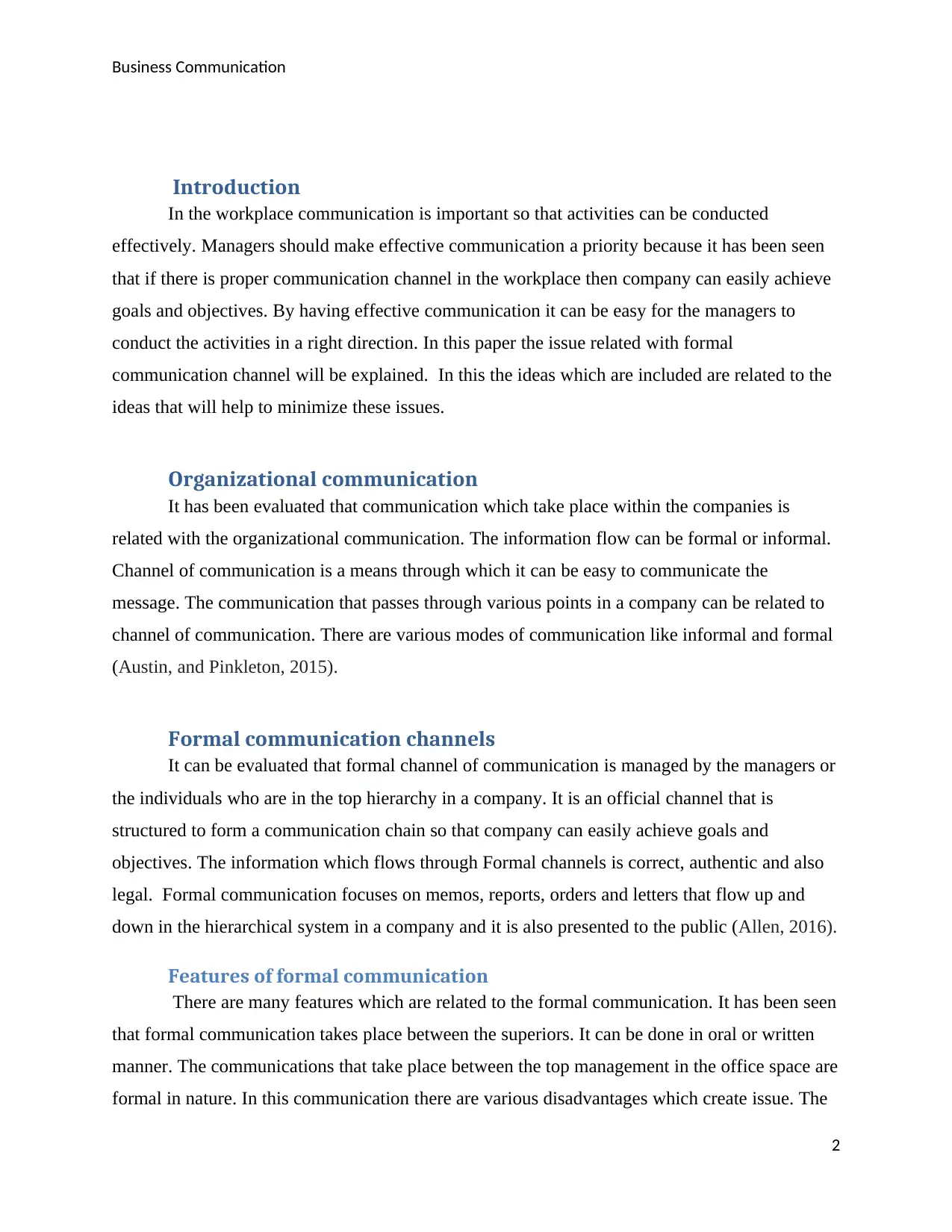
Business Communication
Introduction
In the workplace communication is important so that activities can be conducted
effectively. Managers should make effective communication a priority because it has been seen
that if there is proper communication channel in the workplace then company can easily achieve
goals and objectives. By having effective communication it can be easy for the managers to
conduct the activities in a right direction. In this paper the issue related with formal
communication channel will be explained. In this the ideas which are included are related to the
ideas that will help to minimize these issues.
Organizational communication
It has been evaluated that communication which take place within the companies is
related with the organizational communication. The information flow can be formal or informal.
Channel of communication is a means through which it can be easy to communicate the
message. The communication that passes through various points in a company can be related to
channel of communication. There are various modes of communication like informal and formal
(Austin, and Pinkleton, 2015).
Formal communication channels
It can be evaluated that formal channel of communication is managed by the managers or
the individuals who are in the top hierarchy in a company. It is an official channel that is
structured to form a communication chain so that company can easily achieve goals and
objectives. The information which flows through Formal channels is correct, authentic and also
legal. Formal communication focuses on memos, reports, orders and letters that flow up and
down in the hierarchical system in a company and it is also presented to the public (Allen, 2016).
Features of formal communication
There are many features which are related to the formal communication. It has been seen
that formal communication takes place between the superiors. It can be done in oral or written
manner. The communications that take place between the top management in the office space are
formal in nature. In this communication there are various disadvantages which create issue. The
2
Introduction
In the workplace communication is important so that activities can be conducted
effectively. Managers should make effective communication a priority because it has been seen
that if there is proper communication channel in the workplace then company can easily achieve
goals and objectives. By having effective communication it can be easy for the managers to
conduct the activities in a right direction. In this paper the issue related with formal
communication channel will be explained. In this the ideas which are included are related to the
ideas that will help to minimize these issues.
Organizational communication
It has been evaluated that communication which take place within the companies is
related with the organizational communication. The information flow can be formal or informal.
Channel of communication is a means through which it can be easy to communicate the
message. The communication that passes through various points in a company can be related to
channel of communication. There are various modes of communication like informal and formal
(Austin, and Pinkleton, 2015).
Formal communication channels
It can be evaluated that formal channel of communication is managed by the managers or
the individuals who are in the top hierarchy in a company. It is an official channel that is
structured to form a communication chain so that company can easily achieve goals and
objectives. The information which flows through Formal channels is correct, authentic and also
legal. Formal communication focuses on memos, reports, orders and letters that flow up and
down in the hierarchical system in a company and it is also presented to the public (Allen, 2016).
Features of formal communication
There are many features which are related to the formal communication. It has been seen
that formal communication takes place between the superiors. It can be done in oral or written
manner. The communications that take place between the top management in the office space are
formal in nature. In this communication there are various disadvantages which create issue. The
2
⊘ This is a preview!⊘
Do you want full access?
Subscribe today to unlock all pages.

Trusted by 1+ million students worldwide
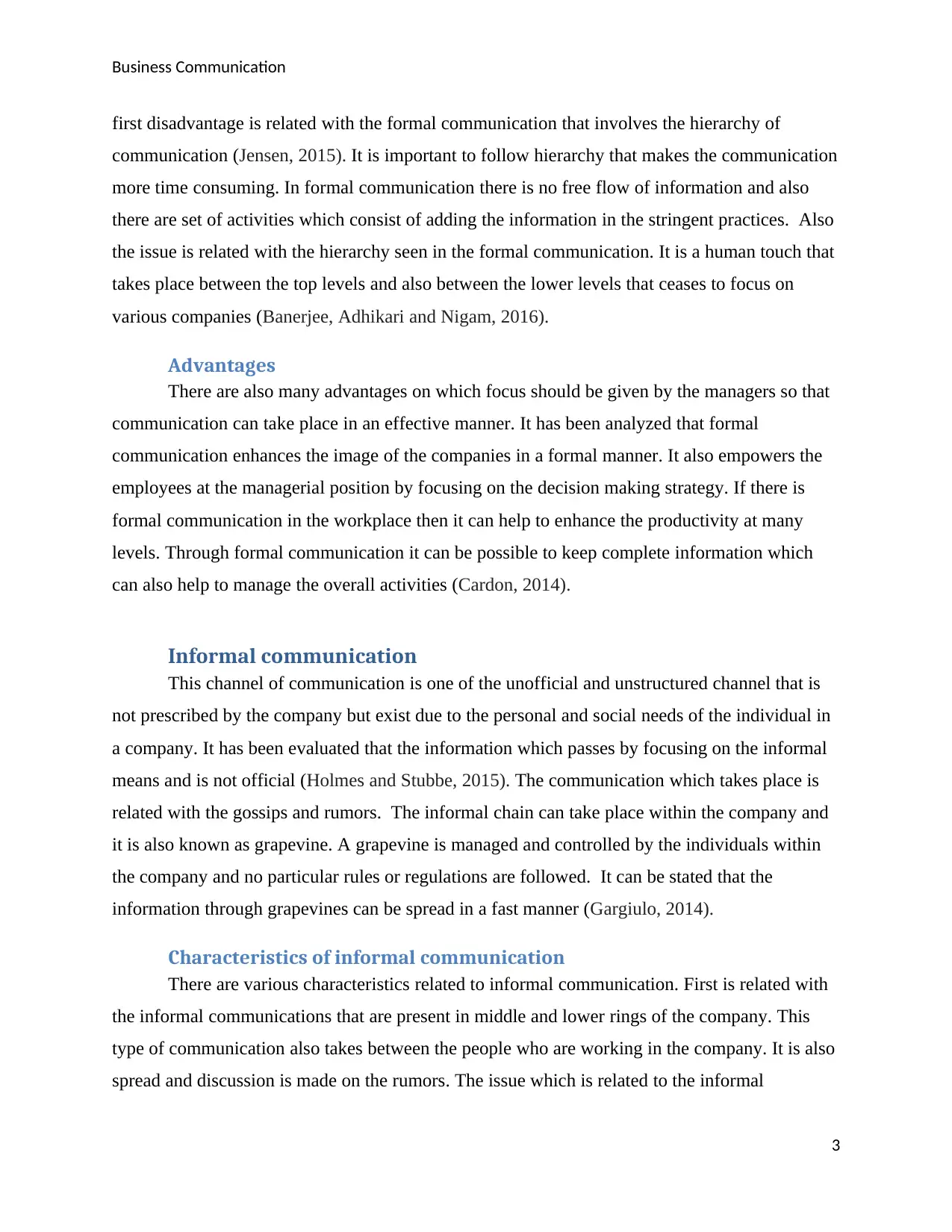
Business Communication
first disadvantage is related with the formal communication that involves the hierarchy of
communication (Jensen, 2015). It is important to follow hierarchy that makes the communication
more time consuming. In formal communication there is no free flow of information and also
there are set of activities which consist of adding the information in the stringent practices. Also
the issue is related with the hierarchy seen in the formal communication. It is a human touch that
takes place between the top levels and also between the lower levels that ceases to focus on
various companies (Banerjee, Adhikari and Nigam, 2016).
Advantages
There are also many advantages on which focus should be given by the managers so that
communication can take place in an effective manner. It has been analyzed that formal
communication enhances the image of the companies in a formal manner. It also empowers the
employees at the managerial position by focusing on the decision making strategy. If there is
formal communication in the workplace then it can help to enhance the productivity at many
levels. Through formal communication it can be possible to keep complete information which
can also help to manage the overall activities (Cardon, 2014).
Informal communication
This channel of communication is one of the unofficial and unstructured channel that is
not prescribed by the company but exist due to the personal and social needs of the individual in
a company. It has been evaluated that the information which passes by focusing on the informal
means and is not official (Holmes and Stubbe, 2015). The communication which takes place is
related with the gossips and rumors. The informal chain can take place within the company and
it is also known as grapevine. A grapevine is managed and controlled by the individuals within
the company and no particular rules or regulations are followed. It can be stated that the
information through grapevines can be spread in a fast manner (Gargiulo, 2014).
Characteristics of informal communication
There are various characteristics related to informal communication. First is related with
the informal communications that are present in middle and lower rings of the company. This
type of communication also takes between the people who are working in the company. It is also
spread and discussion is made on the rumors. The issue which is related to the informal
3
first disadvantage is related with the formal communication that involves the hierarchy of
communication (Jensen, 2015). It is important to follow hierarchy that makes the communication
more time consuming. In formal communication there is no free flow of information and also
there are set of activities which consist of adding the information in the stringent practices. Also
the issue is related with the hierarchy seen in the formal communication. It is a human touch that
takes place between the top levels and also between the lower levels that ceases to focus on
various companies (Banerjee, Adhikari and Nigam, 2016).
Advantages
There are also many advantages on which focus should be given by the managers so that
communication can take place in an effective manner. It has been analyzed that formal
communication enhances the image of the companies in a formal manner. It also empowers the
employees at the managerial position by focusing on the decision making strategy. If there is
formal communication in the workplace then it can help to enhance the productivity at many
levels. Through formal communication it can be possible to keep complete information which
can also help to manage the overall activities (Cardon, 2014).
Informal communication
This channel of communication is one of the unofficial and unstructured channel that is
not prescribed by the company but exist due to the personal and social needs of the individual in
a company. It has been evaluated that the information which passes by focusing on the informal
means and is not official (Holmes and Stubbe, 2015). The communication which takes place is
related with the gossips and rumors. The informal chain can take place within the company and
it is also known as grapevine. A grapevine is managed and controlled by the individuals within
the company and no particular rules or regulations are followed. It can be stated that the
information through grapevines can be spread in a fast manner (Gargiulo, 2014).
Characteristics of informal communication
There are various characteristics related to informal communication. First is related with
the informal communications that are present in middle and lower rings of the company. This
type of communication also takes between the people who are working in the company. It is also
spread and discussion is made on the rumors. The issue which is related to the informal
3
Paraphrase This Document
Need a fresh take? Get an instant paraphrase of this document with our AI Paraphraser
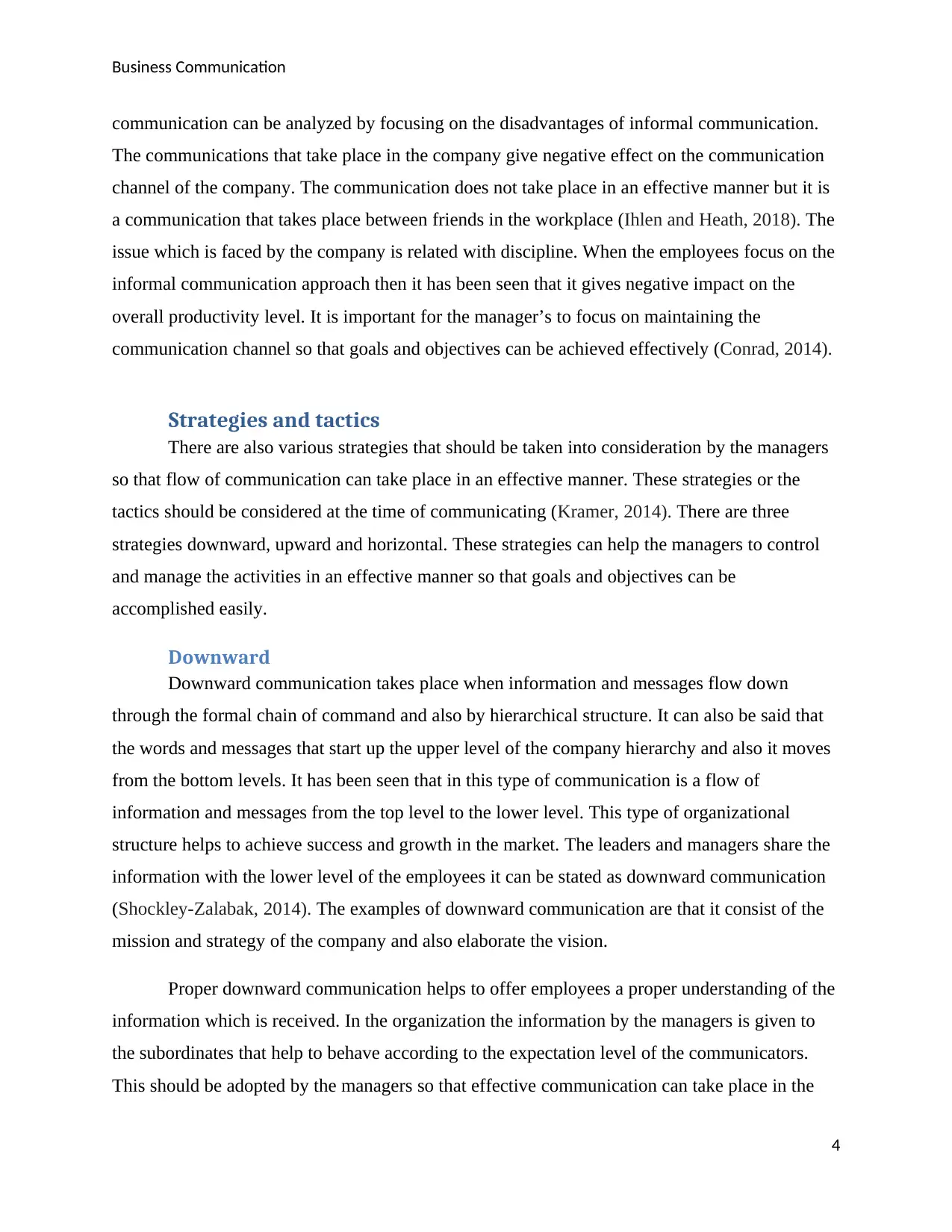
Business Communication
communication can be analyzed by focusing on the disadvantages of informal communication.
The communications that take place in the company give negative effect on the communication
channel of the company. The communication does not take place in an effective manner but it is
a communication that takes place between friends in the workplace (Ihlen and Heath, 2018). The
issue which is faced by the company is related with discipline. When the employees focus on the
informal communication approach then it has been seen that it gives negative impact on the
overall productivity level. It is important for the manager’s to focus on maintaining the
communication channel so that goals and objectives can be achieved effectively (Conrad, 2014).
Strategies and tactics
There are also various strategies that should be taken into consideration by the managers
so that flow of communication can take place in an effective manner. These strategies or the
tactics should be considered at the time of communicating (Kramer, 2014). There are three
strategies downward, upward and horizontal. These strategies can help the managers to control
and manage the activities in an effective manner so that goals and objectives can be
accomplished easily.
Downward
Downward communication takes place when information and messages flow down
through the formal chain of command and also by hierarchical structure. It can also be said that
the words and messages that start up the upper level of the company hierarchy and also it moves
from the bottom levels. It has been seen that in this type of communication is a flow of
information and messages from the top level to the lower level. This type of organizational
structure helps to achieve success and growth in the market. The leaders and managers share the
information with the lower level of the employees it can be stated as downward communication
(Shockley-Zalabak, 2014). The examples of downward communication are that it consist of the
mission and strategy of the company and also elaborate the vision.
Proper downward communication helps to offer employees a proper understanding of the
information which is received. In the organization the information by the managers is given to
the subordinates that help to behave according to the expectation level of the communicators.
This should be adopted by the managers so that effective communication can take place in the
4
communication can be analyzed by focusing on the disadvantages of informal communication.
The communications that take place in the company give negative effect on the communication
channel of the company. The communication does not take place in an effective manner but it is
a communication that takes place between friends in the workplace (Ihlen and Heath, 2018). The
issue which is faced by the company is related with discipline. When the employees focus on the
informal communication approach then it has been seen that it gives negative impact on the
overall productivity level. It is important for the manager’s to focus on maintaining the
communication channel so that goals and objectives can be achieved effectively (Conrad, 2014).
Strategies and tactics
There are also various strategies that should be taken into consideration by the managers
so that flow of communication can take place in an effective manner. These strategies or the
tactics should be considered at the time of communicating (Kramer, 2014). There are three
strategies downward, upward and horizontal. These strategies can help the managers to control
and manage the activities in an effective manner so that goals and objectives can be
accomplished easily.
Downward
Downward communication takes place when information and messages flow down
through the formal chain of command and also by hierarchical structure. It can also be said that
the words and messages that start up the upper level of the company hierarchy and also it moves
from the bottom levels. It has been seen that in this type of communication is a flow of
information and messages from the top level to the lower level. This type of organizational
structure helps to achieve success and growth in the market. The leaders and managers share the
information with the lower level of the employees it can be stated as downward communication
(Shockley-Zalabak, 2014). The examples of downward communication are that it consist of the
mission and strategy of the company and also elaborate the vision.
Proper downward communication helps to offer employees a proper understanding of the
information which is received. In the organization the information by the managers is given to
the subordinates that help to behave according to the expectation level of the communicators.
This should be adopted by the managers so that effective communication can take place in the
4
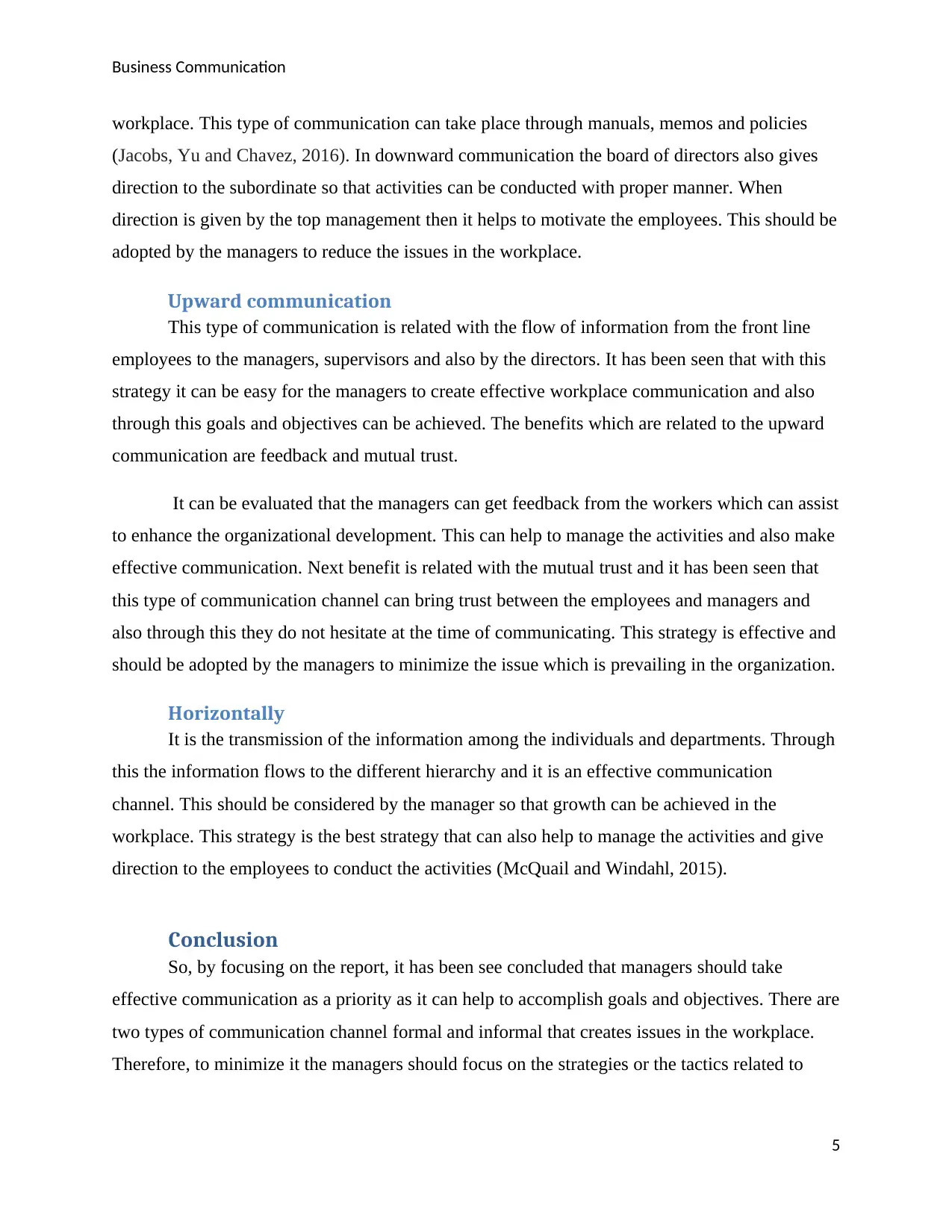
Business Communication
workplace. This type of communication can take place through manuals, memos and policies
(Jacobs, Yu and Chavez, 2016). In downward communication the board of directors also gives
direction to the subordinate so that activities can be conducted with proper manner. When
direction is given by the top management then it helps to motivate the employees. This should be
adopted by the managers to reduce the issues in the workplace.
Upward communication
This type of communication is related with the flow of information from the front line
employees to the managers, supervisors and also by the directors. It has been seen that with this
strategy it can be easy for the managers to create effective workplace communication and also
through this goals and objectives can be achieved. The benefits which are related to the upward
communication are feedback and mutual trust.
It can be evaluated that the managers can get feedback from the workers which can assist
to enhance the organizational development. This can help to manage the activities and also make
effective communication. Next benefit is related with the mutual trust and it has been seen that
this type of communication channel can bring trust between the employees and managers and
also through this they do not hesitate at the time of communicating. This strategy is effective and
should be adopted by the managers to minimize the issue which is prevailing in the organization.
Horizontally
It is the transmission of the information among the individuals and departments. Through
this the information flows to the different hierarchy and it is an effective communication
channel. This should be considered by the manager so that growth can be achieved in the
workplace. This strategy is the best strategy that can also help to manage the activities and give
direction to the employees to conduct the activities (McQuail and Windahl, 2015).
Conclusion
So, by focusing on the report, it has been see concluded that managers should take
effective communication as a priority as it can help to accomplish goals and objectives. There are
two types of communication channel formal and informal that creates issues in the workplace.
Therefore, to minimize it the managers should focus on the strategies or the tactics related to
5
workplace. This type of communication can take place through manuals, memos and policies
(Jacobs, Yu and Chavez, 2016). In downward communication the board of directors also gives
direction to the subordinate so that activities can be conducted with proper manner. When
direction is given by the top management then it helps to motivate the employees. This should be
adopted by the managers to reduce the issues in the workplace.
Upward communication
This type of communication is related with the flow of information from the front line
employees to the managers, supervisors and also by the directors. It has been seen that with this
strategy it can be easy for the managers to create effective workplace communication and also
through this goals and objectives can be achieved. The benefits which are related to the upward
communication are feedback and mutual trust.
It can be evaluated that the managers can get feedback from the workers which can assist
to enhance the organizational development. This can help to manage the activities and also make
effective communication. Next benefit is related with the mutual trust and it has been seen that
this type of communication channel can bring trust between the employees and managers and
also through this they do not hesitate at the time of communicating. This strategy is effective and
should be adopted by the managers to minimize the issue which is prevailing in the organization.
Horizontally
It is the transmission of the information among the individuals and departments. Through
this the information flows to the different hierarchy and it is an effective communication
channel. This should be considered by the manager so that growth can be achieved in the
workplace. This strategy is the best strategy that can also help to manage the activities and give
direction to the employees to conduct the activities (McQuail and Windahl, 2015).
Conclusion
So, by focusing on the report, it has been see concluded that managers should take
effective communication as a priority as it can help to accomplish goals and objectives. There are
two types of communication channel formal and informal that creates issues in the workplace.
Therefore, to minimize it the managers should focus on the strategies or the tactics related to
5
⊘ This is a preview!⊘
Do you want full access?
Subscribe today to unlock all pages.

Trusted by 1+ million students worldwide
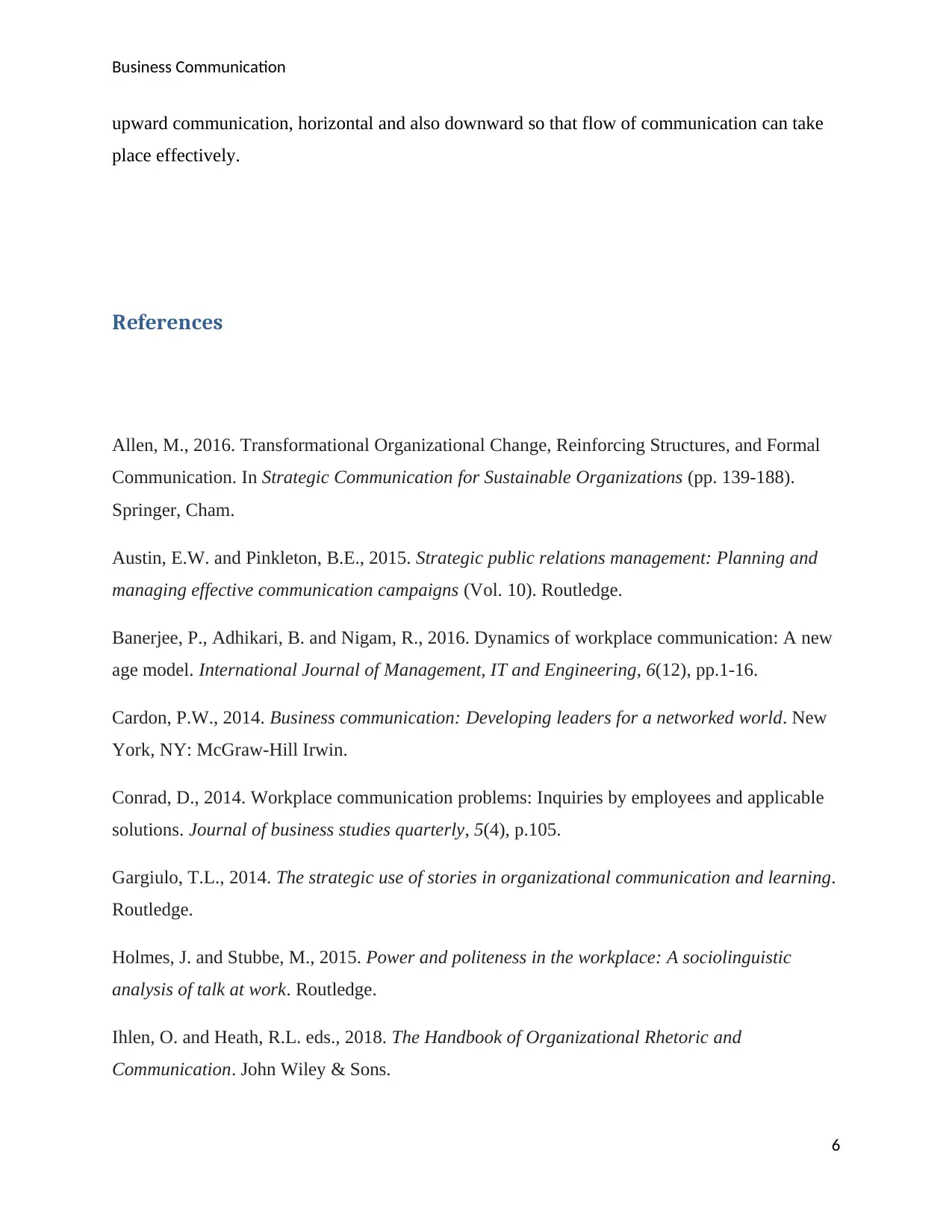
Business Communication
upward communication, horizontal and also downward so that flow of communication can take
place effectively.
References
Allen, M., 2016. Transformational Organizational Change, Reinforcing Structures, and Formal
Communication. In Strategic Communication for Sustainable Organizations (pp. 139-188).
Springer, Cham.
Austin, E.W. and Pinkleton, B.E., 2015. Strategic public relations management: Planning and
managing effective communication campaigns (Vol. 10). Routledge.
Banerjee, P., Adhikari, B. and Nigam, R., 2016. Dynamics of workplace communication: A new
age model. International Journal of Management, IT and Engineering, 6(12), pp.1-16.
Cardon, P.W., 2014. Business communication: Developing leaders for a networked world. New
York, NY: McGraw-Hill Irwin.
Conrad, D., 2014. Workplace communication problems: Inquiries by employees and applicable
solutions. Journal of business studies quarterly, 5(4), p.105.
Gargiulo, T.L., 2014. The strategic use of stories in organizational communication and learning.
Routledge.
Holmes, J. and Stubbe, M., 2015. Power and politeness in the workplace: A sociolinguistic
analysis of talk at work. Routledge.
Ihlen, O. and Heath, R.L. eds., 2018. The Handbook of Organizational Rhetoric and
Communication. John Wiley & Sons.
6
upward communication, horizontal and also downward so that flow of communication can take
place effectively.
References
Allen, M., 2016. Transformational Organizational Change, Reinforcing Structures, and Formal
Communication. In Strategic Communication for Sustainable Organizations (pp. 139-188).
Springer, Cham.
Austin, E.W. and Pinkleton, B.E., 2015. Strategic public relations management: Planning and
managing effective communication campaigns (Vol. 10). Routledge.
Banerjee, P., Adhikari, B. and Nigam, R., 2016. Dynamics of workplace communication: A new
age model. International Journal of Management, IT and Engineering, 6(12), pp.1-16.
Cardon, P.W., 2014. Business communication: Developing leaders for a networked world. New
York, NY: McGraw-Hill Irwin.
Conrad, D., 2014. Workplace communication problems: Inquiries by employees and applicable
solutions. Journal of business studies quarterly, 5(4), p.105.
Gargiulo, T.L., 2014. The strategic use of stories in organizational communication and learning.
Routledge.
Holmes, J. and Stubbe, M., 2015. Power and politeness in the workplace: A sociolinguistic
analysis of talk at work. Routledge.
Ihlen, O. and Heath, R.L. eds., 2018. The Handbook of Organizational Rhetoric and
Communication. John Wiley & Sons.
6
Paraphrase This Document
Need a fresh take? Get an instant paraphrase of this document with our AI Paraphraser
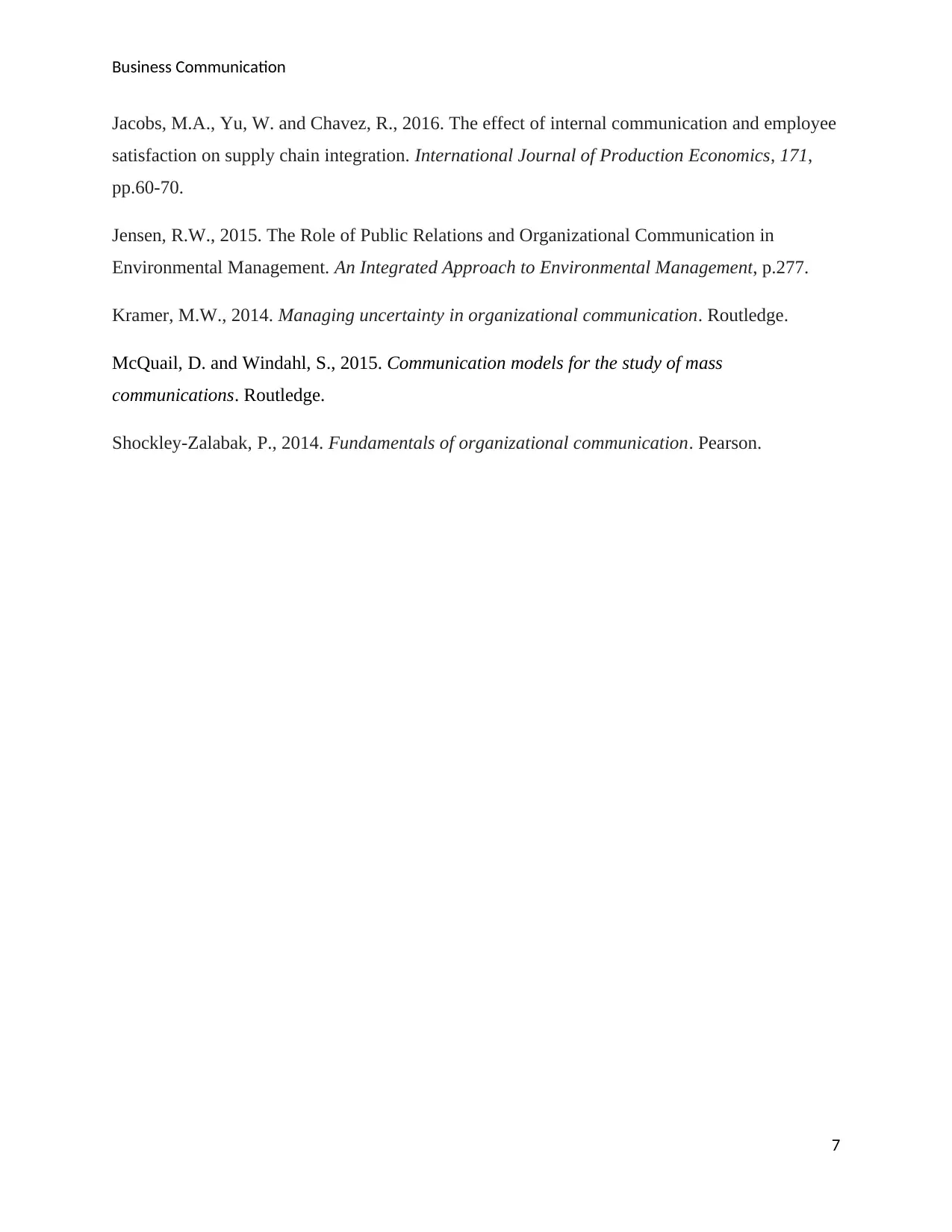
Business Communication
Jacobs, M.A., Yu, W. and Chavez, R., 2016. The effect of internal communication and employee
satisfaction on supply chain integration. International Journal of Production Economics, 171,
pp.60-70.
Jensen, R.W., 2015. The Role of Public Relations and Organizational Communication in
Environmental Management. An Integrated Approach to Environmental Management, p.277.
Kramer, M.W., 2014. Managing uncertainty in organizational communication. Routledge.
McQuail, D. and Windahl, S., 2015. Communication models for the study of mass
communications. Routledge.
Shockley-Zalabak, P., 2014. Fundamentals of organizational communication. Pearson.
7
Jacobs, M.A., Yu, W. and Chavez, R., 2016. The effect of internal communication and employee
satisfaction on supply chain integration. International Journal of Production Economics, 171,
pp.60-70.
Jensen, R.W., 2015. The Role of Public Relations and Organizational Communication in
Environmental Management. An Integrated Approach to Environmental Management, p.277.
Kramer, M.W., 2014. Managing uncertainty in organizational communication. Routledge.
McQuail, D. and Windahl, S., 2015. Communication models for the study of mass
communications. Routledge.
Shockley-Zalabak, P., 2014. Fundamentals of organizational communication. Pearson.
7
1 out of 8
Related Documents
Your All-in-One AI-Powered Toolkit for Academic Success.
+13062052269
info@desklib.com
Available 24*7 on WhatsApp / Email
![[object Object]](/_next/static/media/star-bottom.7253800d.svg)
Unlock your academic potential
Copyright © 2020–2025 A2Z Services. All Rights Reserved. Developed and managed by ZUCOL.




